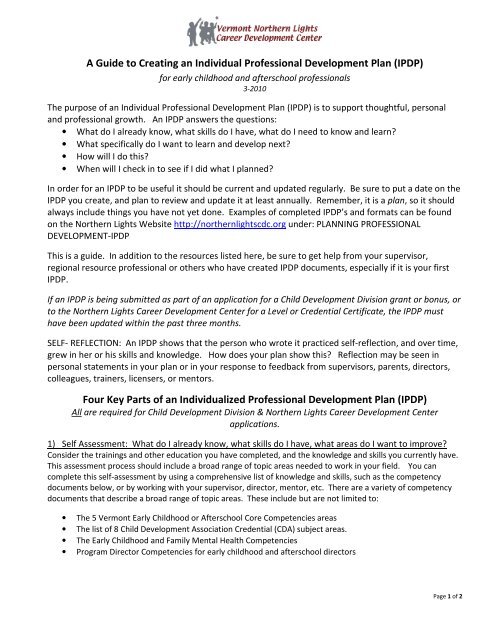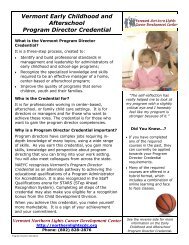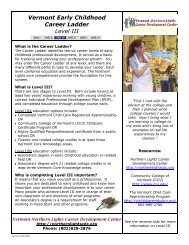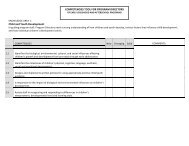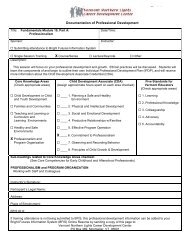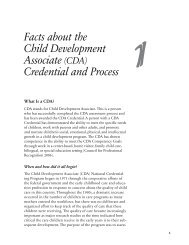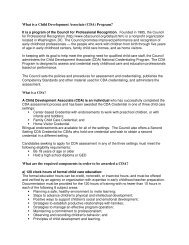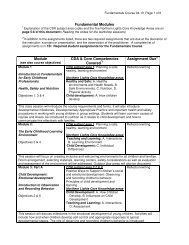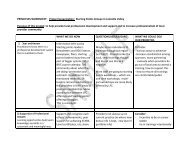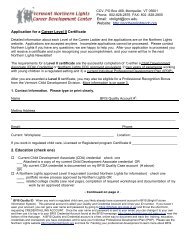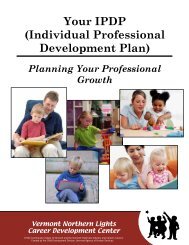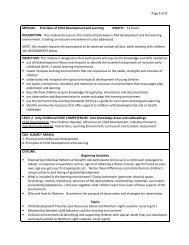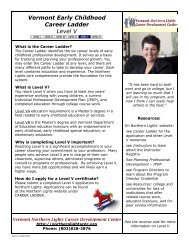A Guide to Creating an Individual Professional Development Plan ...
A Guide to Creating an Individual Professional Development Plan ...
A Guide to Creating an Individual Professional Development Plan ...
You also want an ePaper? Increase the reach of your titles
YUMPU automatically turns print PDFs into web optimized ePapers that Google loves.
A <strong>Guide</strong> <strong>to</strong> <strong>Creating</strong> <strong>an</strong> <strong>Individual</strong> <strong>Professional</strong> <strong>Development</strong> Pl<strong>an</strong> (IPDP)<br />
for early childhood <strong>an</strong>d afterschool professionals<br />
3-2010<br />
The purpose of <strong>an</strong> <strong>Individual</strong> <strong>Professional</strong> <strong>Development</strong> Pl<strong>an</strong> (IPDP) is <strong>to</strong> support thoughtful, personal<br />
<strong>an</strong>d professional growth. An IPDP <strong>an</strong>swers the questions:<br />
• What do I already know, what skills do I have, what do I need <strong>to</strong> know <strong>an</strong>d learn?<br />
• What specifically do I w<strong>an</strong>t <strong>to</strong> learn <strong>an</strong>d develop next?<br />
• How will I do this?<br />
• When will I check in <strong>to</strong> see if I did what I pl<strong>an</strong>ned?<br />
In order for <strong>an</strong> IPDP <strong>to</strong> be useful it should be current <strong>an</strong>d updated regularly. Be sure <strong>to</strong> put a date on the<br />
IPDP you create, <strong>an</strong>d pl<strong>an</strong> <strong>to</strong> review <strong>an</strong>d update it at least <strong>an</strong>nually. Remember, it is a pl<strong>an</strong>, so it should<br />
always include things you have not yet done. Examples of completed IPDP’s <strong>an</strong>d formats c<strong>an</strong> be found<br />
on the Northern Lights Website http://northernlightscdc.org under: PLANNING PROFESSIONAL<br />
DEVELOPMENT-IPDP<br />
This is a guide. In addition <strong>to</strong> the resources listed here, be sure <strong>to</strong> get help from your supervisor,<br />
regional resource professional or others who have created IPDP documents, especially if it is your first<br />
IPDP.<br />
If <strong>an</strong> IPDP is being submitted as part of <strong>an</strong> application for a Child <strong>Development</strong> Division gr<strong>an</strong>t or bonus, or<br />
<strong>to</strong> the Northern Lights Career <strong>Development</strong> Center for a Level or Credential Certificate, the IPDP must<br />
have been updated within the past three months.<br />
SELF- REFLECTION: An IPDP shows that the person who wrote it practiced self-reflection, <strong>an</strong>d over time,<br />
grew in her or his skills <strong>an</strong>d knowledge. How does your pl<strong>an</strong> show this? Reflection may be seen in<br />
personal statements in your pl<strong>an</strong> or in your response <strong>to</strong> feedback from supervisors, parents, direc<strong>to</strong>rs,<br />
colleagues, trainers, licensers, or men<strong>to</strong>rs.<br />
Four Key Parts of <strong>an</strong> <strong>Individual</strong>ized <strong>Professional</strong> <strong>Development</strong> Pl<strong>an</strong> (IPDP)<br />
All are required for Child <strong>Development</strong> Division & Northern Lights Career <strong>Development</strong> Center<br />
applications.<br />
1) Self Assessment: What do I already know, what skills do I have, what areas do I w<strong>an</strong>t <strong>to</strong> improve?<br />
Consider the trainings <strong>an</strong>d other education you have completed, <strong>an</strong>d the knowledge <strong>an</strong>d skills you currently have.<br />
This assessment process should include a broad r<strong>an</strong>ge of <strong>to</strong>pic areas needed <strong>to</strong> work in your field. You c<strong>an</strong><br />
complete this self-assessment by using a comprehensive list of knowledge <strong>an</strong>d skills, such as the competency<br />
documents below, or by working with your supervisor, direc<strong>to</strong>r, men<strong>to</strong>r, etc. There are a variety of competency<br />
documents that describe a broad r<strong>an</strong>ge of <strong>to</strong>pic areas. These include but are not limited <strong>to</strong>:<br />
• The 5 Vermont Early Childhood or Afterschool Core Competencies areas<br />
• The list of 8 Child <strong>Development</strong> Association Credential (CDA) subject areas.<br />
• The Early Childhood <strong>an</strong>d Family Mental Health Competencies<br />
• Program Direc<strong>to</strong>r Competencies for early childhood <strong>an</strong>d afterschool direc<strong>to</strong>rs<br />
Page 1 of 2
All of the above competency frameworks c<strong>an</strong> be viewed <strong>an</strong>d downloaded from<br />
www.northernlightscdc.org under CORE COMPETENCIES.<br />
After you complete the self-assessment, you will have a description or list of what you already know <strong>an</strong>d<br />
c<strong>an</strong> do, <strong>an</strong>d what you w<strong>an</strong>t <strong>to</strong> learn more about.<br />
FOR EXAMPLE, under CHILD DEVELOPMENT you might write:<br />
I KNOW: differences in development between ages 2- 5, I have a basic knowledge of brain development in the<br />
early years; I know about differences in l<strong>an</strong>guage/hearing development for children with multiple ear<br />
infections.<br />
I WANT TO KNOW: what causes differences in behavior in the children in my program, more about<br />
temperament <strong>an</strong>d how <strong>to</strong> better collect information about each child’s development every day.<br />
2) Prioritizing <strong>an</strong>d Goal Setting: What do I w<strong>an</strong>t <strong>to</strong> learn <strong>an</strong>d develop next?<br />
The self-assessment of your knowledge <strong>an</strong>d skills helps you identify specific areas that you would like <strong>to</strong> target for<br />
improvement. You might decide there is a skill that is import<strong>an</strong>t <strong>to</strong> your daily work, or <strong>an</strong> area of knowledge you<br />
w<strong>an</strong>t <strong>to</strong> develop over time. After you review the identified list, choose which ones you w<strong>an</strong>t <strong>to</strong> do first <strong>an</strong>d which<br />
ones later. This process of prioritizing will help your pl<strong>an</strong> be m<strong>an</strong>ageable <strong>an</strong>d me<strong>an</strong>ingful. Now, choose 2-5 areas<br />
you w<strong>an</strong>t <strong>to</strong> develop <strong>an</strong>d clearly describe your goals.<br />
FOR EXAMPLE, you might decide that GOAL #1 is:<br />
Incorporate regular observation <strong>an</strong>d documentation of each child at least weekly.<br />
3) Strategies <strong>an</strong>d Resources: How will I do this?<br />
Once you have your goals <strong>an</strong>d priorities, decide how you will accomplish them. You will need <strong>to</strong> do some<br />
homework so you c<strong>an</strong> be specific about what you will do <strong>to</strong> achieve your goal. Your strategies should include<br />
specific activities <strong>to</strong> help you accomplish your goals such as: gathering materials, interviewing specific people,<br />
visiting specific places <strong>to</strong> observe, contacting specific org<strong>an</strong>izations <strong>an</strong>d agencies, researching specific trainings <strong>to</strong><br />
attend, etc. Also add resources such as written materials you will read, websites you will explore, funding needed<br />
<strong>to</strong> attend events etc.<br />
FOR EXAMPLE, under GOAL #1 you might write:<br />
RESOURCES <strong>an</strong>d STRATEGIES: a) contact Sue at XYZ child care <strong>to</strong> learn how she has set up <strong>an</strong> observation <strong>an</strong>d<br />
documentation system; b) ask if lending library has the book, The Power of Observation- if not check on line<br />
for used prices <strong>an</strong>d order; c) look in the BFIS course calendar for training on Observations of Children or<br />
Temperament<br />
4) Time line: When will I check in <strong>to</strong> see if I did what I pl<strong>an</strong>ned?<br />
Now that you have clear goals, prioritized by which are the most import<strong>an</strong>t <strong>an</strong>d specifically how you will achieve<br />
them, you need <strong>to</strong> add when you pl<strong>an</strong> <strong>to</strong> complete each goal. Put a month <strong>an</strong>d year next <strong>to</strong> each goal <strong>an</strong>d/or<br />
strategy indicating when you expect <strong>to</strong> complete it. Pl<strong>an</strong> <strong>to</strong> check in <strong>to</strong> see that you did what you pl<strong>an</strong>ned, on<br />
those dates.<br />
FOR EXAMPLE, under GOAL #1 you might write:<br />
End of March 2010: contact Sue, look in ‘BFIS course calendar, check lending library<br />
May 1, 2010: start documenting observations<br />
June 1, 2010: review documentation system <strong>an</strong>d check back with Sue, finish book<br />
Sept. 1, 2010: evaluate observations, what I learned <strong>an</strong>d how I am using them.<br />
Remember, your IPDP should be current <strong>an</strong>d updated regularly. Your IPDP is part of the cycle of<br />
professional growth, where you continually review, update <strong>an</strong>d check in on your progress.<br />
Page 2 of 2


